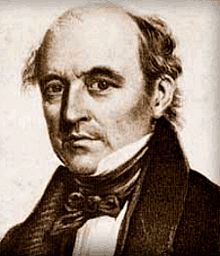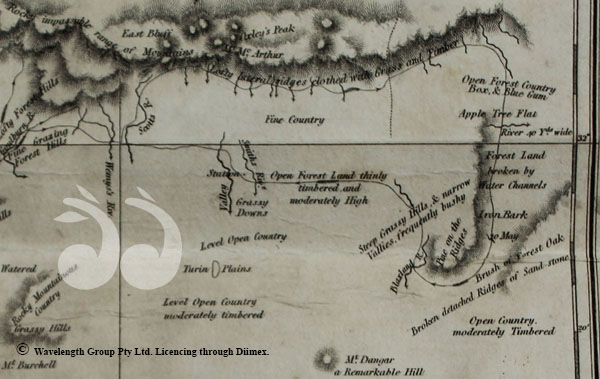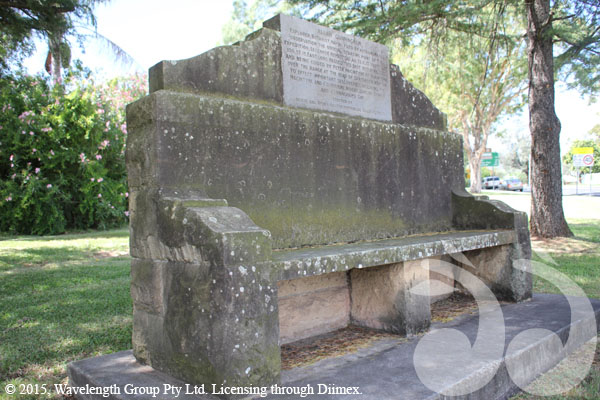Allan Cunningham: 1791–1839

Allan Cunningham, botanist and explorer.
In 1823, the first recorded European person travelled into the Scone area, reaching the upper Dartbrook and Murrurundi area; it was Scottish botanist and explorer, Allan Cunningham.
Cunningham was exploring from Bathurst to the upper Coal River, now known as the Hunter River and as far as the Liverpool Plains. He left Bathurst on April 15, 1823 with five men, five pack horses and ten weeks provisions.1
Earliest description of the Scone area
The diary of Cunningham and initial map provides the earliest description of the Scone area. William Dalton later described Allan Cunningham’s journey giving reference to modern placenames, which gives a clearer perspective of his journey.
“On leaving Bathurst, Cunningham passed through Dabee Plains, which is now known as Rylston. By May 5 he was camped at the Goulburn River near present day Cassilis. He crossed the Krui River, Scott’s Creek and camped within five miles of Oxley’s Peak. For six days he travelled east along the foothills of the Range crossing 19 creeks, one of which would have been the source of the Dartbrook.”2
“In the vicinity of Murrurundi he decided to return to the Cassilis camp by an easier route, and so, turning his back on the range into more open country he followed a southerly direction down the valley of the Kingdon Ponds to a point near Kayuga, then turning Westround Mount Manobalai headed up Wybong creek and so back to the Cassilis camp after an absence of twenty four days, tramping some of the roughest country in the Upper Hunter.”3
In his diary Cunningham describes a river which was at the most easterly point of his exploration, which Dalton estimates to be Murrurundi, where the outer banks were 40 feet wide.4 Judging from his diary description and the map of his journey, he was probably describing the Pages River.

Part of Cunningham’s map shows a river 40ft wide, likely to be the Pages and other local landmarks. Photographed with kind permission from the Mitchell Library, Sydney.
On May 1, Cunningham also passed through an area named Nandoura by the aborigines.5 Years later, the Hall family named their property in the Scone district Nandowra, so there may be a connection in terms of the Aboriginal name for that area.
Cunningham did find a pass through to the Liverpool Plains, which he called Pandora’s Pass. He was not able to go through the Pass, as his provisions were running low.
“I was therefore obliged to content myself with the simple discovery of a practicable passage through a bold range of mountains to them, but for which those unlimited, seemingly abundantly watered, grazing levels would be entirely cloned against us from the southward.”6
A starting point for exploration to Moreton Bay
Allan Cunningham returned to Bathurst, but would return in 1827 when he used Segenhoe as his starting point for an expedition which went over the Great Dividing Range to Moreton Bay.
Cunningham’s Seat in Rotary Park, Scone commemorates when Allan Cunningham passed by the spot in 1827 and would discover the Darling Downs.

The Allan Cunningham Seat in Rotary Park Scone, marks the spot he passed by in his 1827 expedition.
The inscription reads:
“Allan Cunningham, explorer, botanist, having fixed by astronomical observation the official starting point of the expedition, Segenhoe homestead as 36.6.37 south lat 150.57.15 east long passed this spot 30th April, 1827, and being guided by Peter MacIntyre of Blairmore over the Range at the head of the Dartbrook, went on to effect important discoveries, including the MacIntyre and Condamine rivers, Darling Downs and Cunningham’s Gap. Erected by Scone and Upper Hunter Historical Society, 1957.”
Special thanks to:
- the Scone and Upper Hunter Historical Society for their assistance.
Footnotes:
- A.Cunningham, “Journal of a Route from Bathurst to the Liverpool Plains, in New South Wales, explored by Allan Cunningham his Majesty’s Botanical Collector for Kew Gardens”, Geographical memoirs on New South Wales: by various hands, edited by Barron Field, London, 1825, cited on <http://www.archive.org/stream/geographicalmem00fielgoog#page/n14/mode/2up> viewed on 18 February, p.136. [↩]
- W.Dalton, ‘Allan Cunningham’, Scone and Upper Hunter Historical Society Journal, Scone, 1959, p.9. [↩]
- W.Dalton, ‘Allan Cunningham’, Scone and Upper Hunter Historical Society Journal, Volume 1, Scone, 1959, p.10 [↩]
- A.Cunningham, “Journal of a Route from Bathurst to the Liverpool Plains, in New South Wales, explored by Allan Cunningham his Majesty’s Botanical Collector for Kew Gardens”, Geographical memoirs on New South Wales: by various hands, edited by Barron Field, London, 1825, cited on <http://www.archive.org/stream/geographicalmem00fielgoog#page/n14/mode/2up> viewed on 18 February, 2013, p.160. [↩]
- A.Cunningham, “Journal of a Route from Bathurst to the Liverpool Plains, in New South Wales, explored by Allan Cunningham his Majesty’s Botanical Collector for Kew Gardens”, Geographical memoirs on New South Wales: by various hands, edited by Barron Field, London, 1825, cited on <http://www.archive.org/stream/geographicalmem00fielgoog#page/n14/mode/2up> viewed on 18 February, 2013, p.147. [↩]
- A.Cunningham, “Journal of a Route from Bathurst to the Liverpool Plains, in New South Wales, explored by Allan Cunningham his Majesty’s Botanical Collector for Kew Gardens”, Geographical memoirs on New South Wales: by various hands, edited by Barron Field, London, 1825, cited on <http://www.archive.org/stream/geographicalmem00fielgoog#page/n14/mode/2up> viewed on 18 February, 2013, p.177 [↩]
 scone.com.au
scone.com.au